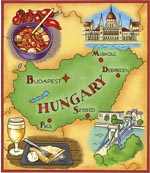City break: Budapest
Isambard Wilkinson reveals in the delights of Hungary’s capital


What I did
A trip on tram Number 2, which must be one of the most beautiful trolley rides in the world. It runs along the Pest bank of the Danube River, offering views that include the soaring Hungarian Parliament Building and, over the water in Buda, the architecturally bejewelled Castle Hill. The track was laid shortly after the Second World War and rattles along past glorious bridges, thickets of Belle Epoque buildings in varying states of health, bauble-spired churches and Turkish baths.
You get an unusual, galloping introduction to the city, and it takes you, more or less, between two useful parameters: Margaret Island (a leafy refuge on a burning summer's day where, at the swimming pool, I ate lángos, an inexplicably irresistible, savoury, grease-sodden doughnut, which has the same effect on the innards as swallowing a stove-pipe sponge) and Petofi Bridge, from where there is an unexpectedly splendid view back on the city. The jaunt is also cheap, or as ticket inspector-dodging locals might say, free.
What I bought
A Mangalica sausage, a bottle of Unicum (a Hungarian restorative flavoured with 40 herbs) and two hats-one made from mushrooms and the other from foetal lambs' wool.
Where I stayed
The glittering, gold-tiled Art Nouveau Gresham Palace hotel (www.fourseasons.com/budapest). A magnificent landmark building that encapsulates much of Budapest's revived fortunes, its imposing bulk, with front corner towers and richly carved façade, looms between St Stephen's Basilica and the Danube. Built in 1904-06 as the overseas headquarters for a London-based insurance company, magnates, artists, cabaret girls and Soviet soldiers passed under its glass-domed lobby before the building fell into a long spell of disrepair. It was painstakingly and luxuriously renovated a decade or so ago and now its stained-glass windows and Zsolnay ceramic tiles reflect the city's rediscovered sparkle.
Exquisite houses, the beauty of Nature, and how to get the most from your life, straight to your inbox.
What I didn't do
Speak the local tongue after my first attempt. When I asked a waiter ‘how are you?' (‘Hogy vagy?'), he replied: ‘We do not drink hot wine in summer.' Nor did I engage a native in conversation on the subject of the 1920 Treaty of Trianon (when Hungary lost two-thirds of her territories).
What I visited
The Hungarian National Museum (www.hnm.hu) has a fittingly eccentric array of objects: a piano played by both Liszt and Beethoven, ivory saddles and a Turkish tent. Besides giving a narrative of the country's perplexing history, the museum also gives an account of what Hungarian friends had hinted at: that their compatriots invented everything, including the Rubik's Cube and the atom bomb.
The Rudas baths are the finest example of a still-functioning Ottoman hammam and as good a place as any among the city's many beautiful baths to make the acquaintance of the 70 million litres (about 15 million gallons) of hot thermal water that bubble up through local limestone on a daily basis. Among coils of steam, marble columns and unabashed Hungarian flesh, you can boil your bones as you play chess or pretend to read a Magyar newspaper.
I attended mass at 10am on Sunday at the magnificent Matthias Church, where an ebullient choir and orchestra performed Kodály's Te Deum. After the service, feeling as if I'd caught a glimpse of the Magyar soul and standing on a parapet of the Fisherman's Bastion, I looked out over the city. It's a treasure box of bullet-riddled, frieze- and gargoyle-festooned fin-de-siècle apartment blocks and I spent much of my time ducking into atmospheric coffee houses (lingering long in the one above Alexandra bookshop on Andrassy Boulevard) and astonishing, often decayed, courtyards.
What surprised me
For all its Turkish baths, little remains of the Ottoman occupation, so it was a pleasure to find the tomb of 16th-century Dervish Gül Baba, perhaps once the most northern holy place of Islam in Europe.
What I ate
Even the daintiest Magyar maiden sets about her victuals with the carnivorous zeal of a starved jackal. I followed suit. At the Gresham Palace, I ate foie gras with rhubarb and cherry, duck-gizzard confit, crushed mustard potato and red-wine cabbage cream. The accompanying wine was a brace of full-bodied reds-one from Villány (Gere Kopár) and the other an Egri Bikavér (Hangács)-and a torrent of sublime Tokaj sweet wines. At a friend's house, I gorged on stuffed cabbage and sour cream garnished with paprika, the sine qua non of Hungarian cuisine. At Macesz Huszár, in the Jewish quarter, I also sampled cholent, a traditional Sabbath dish with a modern twist.
Country Life is unlike any other magazine: the only glossy weekly on the newsstand and the only magazine that has been guest-edited by His Majesty The King not once, but twice. It is a celebration of modern rural life and all its diverse joys and pleasures — that was first published in Queen Victoria's Diamond Jubilee year. Our eclectic mixture of witty and informative content — from the most up-to-date property news and commentary and a coveted glimpse inside some of the UK's best houses and gardens, to gardening, the arts and interior design, written by experts in their field — still cannot be found in print or online, anywhere else.
